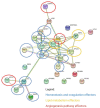Novel Possible Protein Targets in Neovascular Age-Related Macular Degeneration: A Pilot Study Experiment
- PMID: 35155457
- PMCID: PMC8828634
- DOI: 10.3389/fmed.2021.692272
Novel Possible Protein Targets in Neovascular Age-Related Macular Degeneration: A Pilot Study Experiment
Abstract
Age-related macular degeneration (AMD) is among the world's leading causes of blindness. In its neovascular form (nAMD), around 25% of patients present further anatomical and visual deterioration due to persistence of neovascular activity, despite gold-standard treatment protocols using intravitreal anti-VEGF medications. Thus, to comprehend, the molecular pathways that drive choroidal neoangiogenesis, associated with the vascular endothelial growth factor (VEGF), are important steps to elucidate the mechanistic events underneath the disease development. This is a pilot study, a prospective, translational experiment, in a real-life context aiming to evaluate the protein profiles of the aqueous humor of 15 patients divided into three groups: group 1, composed of patients with nAMD, who demonstrated a good response to anti-VEGF intravitreal injections during follow-up (good responsive); group 2, composed of patients with anti-VEGF-resistant nAMD, who demonstrated choroidal neovascularization activity during follow-up (poor/non-responsive); and group 3, composed of control patients without systemic diseases or signs of retinopathy. For proteomic characterization of the groups, mass spectrometry (label-free LC-MS/MS) was used. A total of 2,336 proteins were identified, of which 185 were distinctly regulated and allowed the differentiation of the clinical conditions analyzed. Among those, 39 proteins, including some novel ones, were analyzed as potential disease effectors through their pathophysiological implications in lipid metabolism, oxidative stress, complement system, inflammatory pathways, and angiogenesis. So, this study suggests the participation of other promising biomarkers in neovascular AMD, in addition to the known VEGF.
Keywords: AMD (age-related macular degeneration); biomarkers; choroidal neo vascularization; mass spectrometry (MS); proteomics; resistance.
Copyright © 2022 Coronado, da Cunha, de Oliveira, Nóbrega, Ricart, Fontes, de Sousa, de Ávila and Martins.
Conflict of interest statement
The authors declare that the research was conducted in the absence of any commercial or financial relationships that could be construed as a potential conflict of interest.
Figures





Similar articles
-
Inflammatory Factors of Macular Atrophy in Eyes With Neovascular Age-Related Macular Degeneration Treated With Aflibercept.Front Immunol. 2021 Oct 13;12:738521. doi: 10.3389/fimmu.2021.738521. eCollection 2021. Front Immunol. 2021. PMID: 34721402 Free PMC article.
-
Molecular Biomarkers of Neovascular Age-Related Macular Degeneration With Incomplete Response to Anti-Vascular Endothelial Growth Factor Treatment.Front Pharmacol. 2020 Dec 29;11:594087. doi: 10.3389/fphar.2020.594087. eCollection 2020. Front Pharmacol. 2020. PMID: 33447243 Free PMC article.
-
Neovascular age-related macular degeneration: intraocular cytokines and growth factors and the influence of therapy with ranibizumab.Ophthalmology. 2009 Dec;116(12):2393-9. doi: 10.1016/j.ophtha.2009.05.039. Epub 2009 Oct 7. Ophthalmology. 2009. PMID: 19815292 Clinical Trial.
-
Resistance to anti-VEGF therapy in neovascular age-related macular degeneration: a comprehensive review.Drug Des Devel Ther. 2016 Jun 2;10:1857-67. doi: 10.2147/DDDT.S97653. eCollection 2016. Drug Des Devel Ther. 2016. PMID: 27330279 Free PMC article. Review.
-
Profile of conbercept in the treatment of neovascular age-related macular degeneration.Drug Des Devel Ther. 2015 Apr 22;9:2311-20. doi: 10.2147/DDDT.S67536. eCollection 2015. Drug Des Devel Ther. 2015. PMID: 25960634 Free PMC article. Review.
Cited by
-
Essential Role of Multi-Omics Approaches in the Study of Retinal Vascular Diseases.Cells. 2022 Dec 26;12(1):103. doi: 10.3390/cells12010103. Cells. 2022. PMID: 36611897 Free PMC article. Review.
-
Advances in aqueous humor proteomics for biomarker discovery and disease mechanisms exploration: a spotlight on primary open angle glaucoma.Front Mol Neurosci. 2024 Apr 24;17:1397461. doi: 10.3389/fnmol.2024.1397461. eCollection 2024. Front Mol Neurosci. 2024. PMID: 38721264 Free PMC article. Review.
-
Indications of the SERPINE 1 variant rs1799768's role in anti-VEGF therapy resistance in neovascular age-related macular degeneration.PLoS One. 2025 Mar 6;20(3):e0317511. doi: 10.1371/journal.pone.0317511. eCollection 2025. PLoS One. 2025. PMID: 40048436 Free PMC article.
-
Recent Advances in Proteomics-Based Approaches to Studying Age-Related Macular Degeneration: A Systematic Review.Int J Mol Sci. 2022 Nov 25;23(23):14759. doi: 10.3390/ijms232314759. Int J Mol Sci. 2022. PMID: 36499086 Free PMC article.
-
Pinpointing Novel Plasma and Brain Proteins for Common Ocular Diseases: A Comprehensive Cross-Omics Integration Analysis.Int J Mol Sci. 2024 Sep 24;25(19):10236. doi: 10.3390/ijms251910236. Int J Mol Sci. 2024. PMID: 39408566 Free PMC article.
References
-
- Ávila MP de, Garcia JM, Isaac DLC. Degeneração macular relacionada à idade: presente e futuro e-OftalmoCBO. Rev Digit Oftalmol. (2015) 1:1–9. 10.17545/e-oftalmo.cbo/2015.18 - DOI
LinkOut - more resources
Full Text Sources

